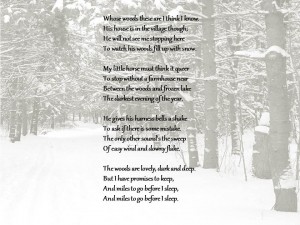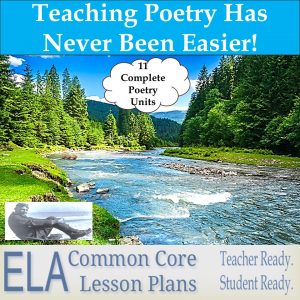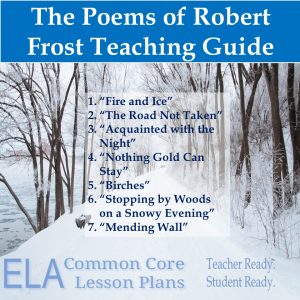I just found out that on this date in 1923, “Stopping by Woods on a Snowy Evening” was published. I found out long ago that most people that aren’t English teachers don’t care about such things.
Luckily, you’re an English teacher and I’ve gathered a few things I’ve done over the years with Robert Frost, poetry, and “Stopping by Woods on a Snowy Evening.”
Let’s start with the poem.
As you’ve carefully noted, “Stopping by Woods on a Snowy Evening” was published in 1923, meaning it’s now in the public domain, so I can include the poem here.
 “Stopping by Woods on a Snowy Evening” by Robert Frost
“Stopping by Woods on a Snowy Evening” by Robert Frost
Whose woods these are I think I know.
His house is in the village though;
He will not see me stopping here
To watch his woods fill up with snow.
My little horse must think it queer
To stop without a farmhouse near
Between the woods and frozen lake
The darkest evening of the year.
He gives his harness bells a shake
To ask if there is some mistake.
The only other sound’s the sweep
Of easy wind and downy flake.
The woods are lovely, dark and deep.
But I have promises to keep,
And miles to go before I sleep,
And miles to go before I sleep.
Let’s talk about a Robert Frost Poetry Lesson Plan
This isn't just a Robert Frost Poetry Lesson Plan, it's a lesson plan to teach any poem. If you want the entire poetry lesson plan, just follow the link. I've copied the highlights here, beginning with how to annotate a poem.
- Write the poem on the board or print this: "Stopping By Woods on a Snowy Evening" handout.
- Read the poem aloud.
- Instruct students to identify the following elements and make notations: rhyme scheme, figurative language, images, symbols, sound devices (alliteration, consonance, assonance, rhythm, onomatopoeia, off rhyme).
- Instruct students to circle any part of the poem that stands out, confuses them, or is important.
- Write questions in the margin; highlight unusual words; mark phrases that indicate the poem’s meaning.
- Determine the poem’s theme and draw arrows to the lines that support the theme.
This may take a practice poem or two, but most students get the hang of it pretty fast.
After about 10 minutes, try the following procedures.
- Hand a white board marker to a student and instruct him or her to identify the rhyme scheme (on the board).
- Hand a marker to another student and have him or her identify figurative language.
- Choose a different student for each of the following: images, symbols, metaphors, similes, sound devices, and meaningful lines.
- Ask for volunteers to come up and add anything they wish to the board annotations. They may be shy at first. If so, throw the marker and choose the student it lands closest to.
- You may have anywhere from 1-5 students at the board at once while the remainder of the class continues writing on their own paper.
- Feel free to make a few annotations yourself to keep things rolling. It’s important to encourage students. Acknowledge all efforts with appreciation.
- Revel in the words of master poets.
- Start singing one of my favorite songs. Simply repeat "Stopping by Woods on a Snowy Evening" over and over in a high pitched voice with an occasional pitch change (I'm not a music guy so if I got the terms wrong, sorry). It's a great song.
After you've done a class annotation, instruct students to write a paragraph analysis of the poem. I've provided a handout you can use. There's a copy of the poem to annotate on the left side and a space to write an analysis on the right side: "Stopping By Woods on a Snowy Evening" handout.
Here's my analysis

Imagine having 11 complete poetry units with handouts and lesson plans completed. You don't need to imagine. These units are teacher ready and student ready. Just print, make copies, and accept accolades from colleagues and students.
Here's a little something I wrote many years ago for RealStudyGuides.net.
- rhyme scheme: a a b a b b c b c c d c d d d d
- meter = iambic tetrameter
- the rhyme scheme represents the ever present hand of death reaching back to get us.
- the rhyme scheme jolts the reader: we are given a couplet to open each stanza and instinctively expect a couplet to end each stanza. Instead the stanza ends with an additional line of rhyme for the couplet. It's familiar, but not what we expect. Death, too, is familiar, but often comes unexpectedly.
- The poem takes place in the dead of winter as the speaker watches the "woods fill up with snow" (4).
- Nearby is a frozen lake (lifeless). It's the darkest evening of the year--death.
- The horse senses something amiss and shakes his bells, knocking the speaker and the reader out of a trance.
- Line 13 - "The woods are lovely, dark, and deep." Sounds inviting to the reader--the chance to rest eternally.
- Lines 14-16 - The speaker realizes it's not his time to enter the woods. He has "promises to keep" (14), and "miles to go before I sleep" (16).
Paragraph Analysis of "Stopping by Woods on a Snowy Evening" by Robert Frost
How about a Song Performed by Me
Last Updated on March 12, 2018 by Trenton Lorcher
Share This:

Not all of Robert Frost’s poems are about death (I know, hard to believe). I always tell my students that there is no “set” interpretation of any poem. I once heard a recording of Frost discussing “Two Roads Diverged in a Yellow Wood,” and I was taken aback by his take on his own poem. IN the case of the one here under current discussion, I view this poem as somewhat of a lament about having to leave the area where he is so familiar (And miles to go…). Furthermore, Mr Lorcher igorned the line containing the words”…the shortest evening of the year” and “Of easy wind and downy flake.” All that said, Mr. Lorcher, what a fabulous discussion of ne of my favorite poems. Thank you for sharing.
Thanks for the kind words, Larry. The beauty of great poetry is its ability to reach all people at different levels. That’s why teaching Frost and other greats is such a pleasure.